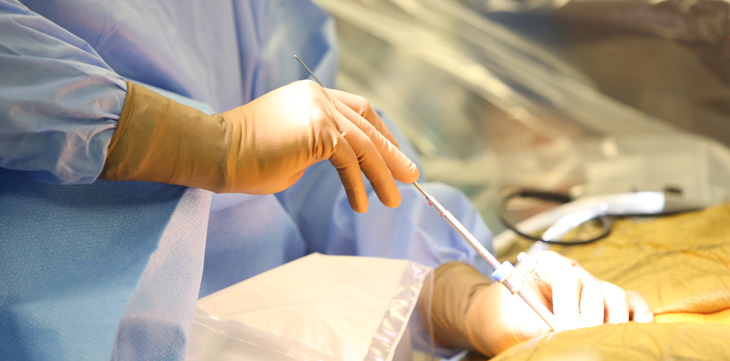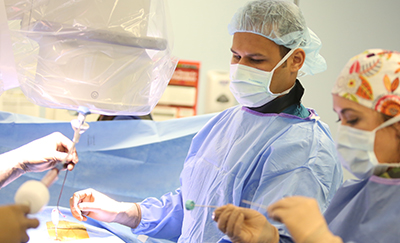MIS PLIF
The PLIF procedure is a minimally disruptive approach to traditional back surgery. During a PLIF (Posterior Lumbar Interbody Fusion) procedure, the damaged disc is removed from between two vertebrae in the lower back (the lumbar region). The vertebrae are then fused together to reduce motion. The goals of the procedure are to restore stability in the spine, eliminate pain, and treat common spinal pathologies.
 Traditionally, a PLIF is performed by making a midline incision in the patient’s back. The attached muscles are then pulled back and laterally (to the side) to allow sufficient exposure for the surgeon to place pedicle screws for fixation. This often results in postoperative approach-related muscle pain and denervation (loss of nerve supply).
Traditionally, a PLIF is performed by making a midline incision in the patient’s back. The attached muscles are then pulled back and laterally (to the side) to allow sufficient exposure for the surgeon to place pedicle screws for fixation. This often results in postoperative approach-related muscle pain and denervation (loss of nerve supply).
The distinct difference between a traditional “open” PLIF and a MIS (minimally invasive surgery) PLIF, is the medialized surgical approach. By using a medialized (closer to the spinous process) screw entry point, the MIS PLIF procedure is designed to eliminate the need to retract muscle laterally past the facet joint to the transverse process, therefore requiring a smaller incision than an “open” PLIF. By minimizing the amount of muscle disruption, this procedure is intended to reduce postoperative approach-related muscle pain and enable a faster recovery for the patient.
Advantages of Minimally Invasive PLIF
In general, the MIS PLIF procedure results in a shorter recovery and a faster return to normal activities compared to a traditional “open” PLIF procedure. Benefits include:
- Reduced blood loss compared to a traditional PLIF procedure – the MIS PLIF procedure requires a smaller incision and causes less muscle disruption than a traditional PLIF.
- Minimal scarring and postoperative pain – the MIS PLIF procedure avoids excessive lateral dissection/retraction that can cause trauma to and denervation of back muscles.
- Reduced hospital stay – most MIS PLIF patients are discharged from the hospital 1-2 days after surgery.
- Faster return to normal activity – because this procedure is less disruptive than conventional posterior surgery, most patients are able to stand up and walk the evening after surgery.
Potential Risks
All surgical procedures present risks and complications, and it is important to discuss them with your surgeon prior to surgery. Listening to your surgeon’s guidance, both before and after surgery, will help to encourage the best possible outcome from your procedure.
Operative and postoperative complications known to occur may include: early or late infection which may result in the need for additional surgeries; damage to the spinal cord or peripheral nerves, pulmonary emboli; loss of sensory and/or motor function; permanent pain and/or deformity. Rarely, some complications may be fatal.
Maahir Haque, MD is recognized as a leader in the field of minimally invasive spine surgery. At Spine Group Orlando, Dr. Maahir Haque also provides second opinions for spine surgery and MRI reviews for those with back pain and neck pain. Dr. Haque emphasizes non-surgical options for back pain and neck pain where possible. This can include accessing a back pain specialist with expertise in pain-relieving spinal injections and spine therapists. Spine therapy can include back stretches that can be a future home remedy for back pain or neck pain. If spine surgery is necessary because of a herniated disc, spinal fracture, or spinal stenosis, Dr. Maahir Haque operates through tubular retractors that reduce the size of the incision, lessen blood loss, reduce time in the hospital, speed return to activity with a less painful recovery. This spine surgery expertise enables many patients to have outpatient spine surgery and be home the same day. Spine Group Orlando and Dr. Maahir Haque provides artificial disc replacement in the neck using the Mobi-C disc implant, the first FDA-approved disc for multiple levels in the neck. Prodisc-C is also used for artificial disc replacement in the cervical spine. Dr. Haque is also one of the few spine surgeons in Orlando, Florida to provide lumbar artificial disc replacement using the Prodisc-L artificial disc. Dr. Haque is also referred patients from across Orlando and north central Florida for artificial disc replacement surgery as an alternative to spinal fusion. Accordingly, Dr. Haque's patients travel from across north central Florida, including: Orlando; Jacksonville; Tallahassee; Lakeland; Gainesville; Tampa; Daytona Beach; and Cocoa Beach. The spine center, as a destination for medical tourism for some international patients from Mexico and the Caribbean, can provide recommendations to out-of-town patients on nearby hotels and tourist attractions. Dr. Haque is featured on the national site CentersforArtificialDisc.com as an author on the subject of artificial disc replacement for herniated discs in the neck. The Centers for Artificial Disc web site has content specific to disc replacement options and alternatives to spinal fusion. Click here to visit the Centers for Artificial Disc.







